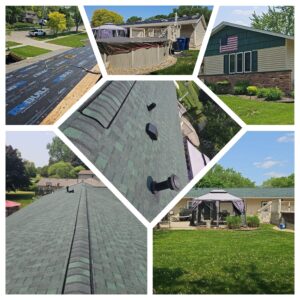Roof installation is a crucial aspect of constructing or renovating a building, whether it’s a residential home, commercial establishment, or industrial facility. A well-installed roof not only enhances the aesthetic appeal of the structure but also provides vital protection against the elements, ensuring the integrity and longevity of the building. In this section, we’ll delve into the key considerations and steps involved in roof installation, highlighting best practices to achieve optimal results.
- Planning and Preparation: Before commencing roof installation, thorough planning and preparation are essential. This phase involves several key steps:
- Assessment of existing structure: Evaluate the existing roof condition, substrate, and any underlying issues such as water damage, rot, or structural weaknesses.
- Selection of roofing materials: Choose appropriate roofing materials based on factors like climate, budget, durability, and aesthetic preferences. Options range from asphalt shingles and metal roofing to clay tiles and synthetic materials.
- Obtaining necessary permits: Ensure compliance with local building codes and regulations by obtaining permits for the roof installation project.
- Safety measures: Implement comprehensive safety protocols to protect workers and occupants during the installation process, including fall protection systems, proper equipment, and training.
- Surface Preparation: Preparing the roof surface is crucial to ensure proper adhesion and performance of the roofing materials. This involves:
- Removal of existing roofing: If replacing an old roof, remove the existing roofing materials down to the substrate, inspecting for any underlying issues that need addressing.
- Repair and replacement: Address any damaged or deteriorated substrate, decking, or structural components before proceeding with installation.
- Installation of underlayment: Apply a waterproof underlayment to serve as a secondary barrier against moisture infiltration, enhancing the roof’s resilience.
- Installation Techniques: The installation techniques may vary depending on the type of roofing material chosen. However, some general principles apply:
- Proper alignment and fastening: Ensure accurate alignment and secure fastening of roofing materials to prevent leaks, wind uplift, and premature deterioration.
- Flashing and sealants: Install flashing components around roof penetrations, edges, and valleys to redirect water flow and prevent water intrusion. Proper application of sealants further enhances waterproofing and weatherproofing.
- Ventilation: Incorporate adequate ventilation systems to promote airflow and prevent moisture buildup in the attic or roof cavity, which can lead to mold, rot, and structural damage.
- Quality Assurance and Inspection: Throughout the roof installation process, regular quality assurance checks and inspections are vital to identify and address any issues promptly. This involves:
- Monitoring workmanship: Supervise the installation to ensure adherence to manufacturer guidelines, industry best practices, and safety standards.
- Inspecting for defects: Conduct comprehensive inspections at various stages of installation to detect any defects, errors, or deficiencies that may compromise the roof’s performance.
- Final assessment: Upon completion of installation, perform a final inspection to verify the integrity, functionality, and aesthetic appeal of the roof.
Conclusion: Roof installation demands meticulous planning, skilled craftsmanship, and adherence to quality standards to achieve a durable, weather-resistant, and aesthetically pleasing result. By following best practices, employing proper techniques, and prioritizing quality assurance, property owners can enjoy the benefits of a well-installed roof, safeguarding their investment and ensuring long-term protection against the elements.


